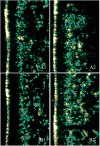Synergistic effect of microneedle-delivered extracellular matrix compound and radiofrequency on rejuvenation of periorbital wrinkles
- PMID: 35935789
- PMCID: PMC9355126
- DOI: 10.3389/fmed.2022.900784
Synergistic effect of microneedle-delivered extracellular matrix compound and radiofrequency on rejuvenation of periorbital wrinkles
Abstract
Background: A combination of minimally invasive modalities can induce collagen regeneration more quickly and promote the penetration of topical agents, thus promoting skin rejuvenation. In this study, we aimed to investigate the synergistic efficacy of extracellular matrix compound (ECM-C) via microneedle (MN) and radiofrequency (RF) on periorbital wrinkles.
Method: A total of 25 participants with periorbital wrinkles were selected for this study. The left and right side of the periorbital area was randomly given ECM-C via MN or ECM-C via MN combined with RF. MN combined with ECM-C treatment was given 5 times at 2 weeks intervals, whereas RF treatment was given 3 times at 4-week intervals. The following items were assessed: wrinkles by VISIA® system; biophysical parameters such as skin hydration, transepidermal water loss (TEWL), erythema index, and melanin index by CK multiple probe adapter; and skin elasticity and skin thickness by DermaLab Combo® photographs were taken at the baseline and 2 weeks after the last treatment. Subjective assessments, such as Crow's Feet Grading Scale (CFGS) and Global Aesthetic International Scale (GAIS), were also recorded.
Result: A total of 25 participants with an average age of 43 years participated in this trial. Periorbital wrinkles on both sides decreased after the treatment, and the side treated with ECM via MN and RF showed better improvement than the other side with ECM-C via MN alone. Skin hydration increased after the treatment on both sides. TEWL, skin erythema, and skin melanin indexes were not changed. Skin elasticity and skin thickness increased more on the side of ECM-C via MN and RF than on the other side of ECM-C via MN alone. The evaluation scores for CFGS improved on either side; however, no difference was found for CFGS and GAIS between intergroup comparisons after the treatment.
Conclusion: The objective assessment of wrinkles, elasticity, and thickness of periorbital skin improved more on the side with ECM-C treatment via MN combined with RF than on the other side of ECM-C treatment via MN only. However, no statistically significant difference was found between the subjective CFGS and GAIS evaluation of the two sides.
Keywords: extracellular matrix; microneedle; periorbital wrinkles; radiofrequency; skin biophysical parameters.
Copyright © 2022 Cheng, Zhang and Zhuo.
Figures








Similar articles
-
Periorbital Skin Rejuvenation of Asian Skin Using Microneedle Fractional Radiofrequency.Ann Dermatol. 2023 Oct;35(5):360-366. doi: 10.5021/ad.22.217. Ann Dermatol. 2023. PMID: 37830418 Free PMC article.
-
Comparison of microneedle fractional radiofrequency therapy with intradermal botulinum toxin a injection for periorbital rejuvenation.Dermatology. 2013;227(4):367-72. doi: 10.1159/000356162. Epub 2013 Nov 21. Dermatology. 2013. PMID: 24280617 Clinical Trial.
-
Hyaluronic acid microneedle patch for the improvement of crow's feet wrinkles.Dermatol Ther. 2017 Nov;30(6). doi: 10.1111/dth.12546. Epub 2017 Sep 11. Dermatol Ther. 2017. PMID: 28892233 Clinical Trial.
-
A review of the efficacy of popular eye cream ingredients.Int J Womens Dermatol. 2024 Jun 13;10(2):e156. doi: 10.1097/JW9.0000000000000156. eCollection 2024 Jun. Int J Womens Dermatol. 2024. PMID: 38873621 Free PMC article. Review.
-
Physiological Mechanisms and Therapeutic Applications of Microneedling: A Narrative Review.Cureus. 2025 Mar 13;17(3):e80510. doi: 10.7759/cureus.80510. eCollection 2025 Mar. Cureus. 2025. PMID: 40225445 Free PMC article. Review.
Cited by
-
Longevity cosmeceuticals as the next frontier in cosmetic innovation: a scientific framework for substantiating product claims.Front Aging. 2025 May 22;6:1586999. doi: 10.3389/fragi.2025.1586999. eCollection 2025. Front Aging. 2025. PMID: 40475790 Free PMC article. Review.
References
LinkOut - more resources
Full Text Sources
Research Materials

